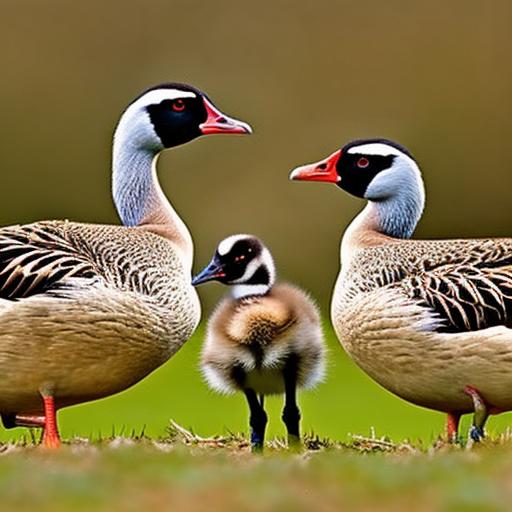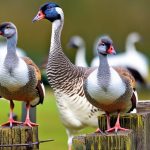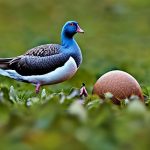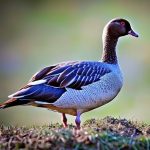Geese are known for their strong family bonds and intricate breeding behavior. They are monogamous birds, meaning they form long-term pair bonds with a single mate. Geese typically breed in the spring and summer months, when food is abundant and the weather is favorable for raising young. During the breeding season, geese exhibit a variety of behaviors related to mating, nesting, and caring for their offspring. Understanding the breeding behavior of geese is important for conservation efforts and for those who keep geese in captivity.
Geese are highly social birds and often form large flocks, especially during migration. However, when it comes to breeding, they pair off into monogamous couples. These pairs will often return to the same breeding grounds year after year, reinforcing their bond and familiarity with the area. Geese are also known for their strong territorial instincts during the breeding season, often aggressively defending their nesting sites from other geese and potential predators. This territorial behavior is an important aspect of their breeding behavior, as it helps ensure the safety and security of their offspring. Overall, geese breeding behavior is a fascinating and complex aspect of their biology that plays a crucial role in their reproductive success.
Mating and Courtship Rituals
Geese engage in elaborate courtship rituals as part of their mating behavior. These rituals often involve displays of affection and bonding between mates. One common courtship behavior is the “triumph ceremony,” in which the male goose will stretch his neck out and make a series of honking calls while the female responds with similar calls. This ritual serves to strengthen the pair bond and establish the male’s dominance in the relationship. Another important aspect of geese mating behavior is the formation of pair bonds through mutual grooming and preening. This grooming behavior helps to reinforce the bond between mates and is an important part of their courtship rituals.
During courtship, geese also engage in various displays of affection, such as head bobbing, wing flapping, and bill dipping. These displays serve to communicate the pair’s readiness to mate and reinforce their bond. Once a pair has formed, they will often engage in synchronized swimming and other coordinated movements as part of their courtship rituals. These displays not only serve to strengthen the pair bond but also help to establish the pair’s dominance within their territory. Overall, geese mating and courtship rituals are complex and fascinating behaviors that play a crucial role in their reproductive success.
Nesting and Egg Laying
After forming a pair bond, geese will begin to search for a suitable nesting site. Geese typically prefer to nest near water, such as on islands or along the shores of lakes or rivers. They will often build their nests on the ground, using grasses, reeds, and other vegetation to create a shallow depression in which to lay their eggs. Geese are known for their strong territorial instincts during the nesting period and will aggressively defend their nesting sites from other geese and potential predators.
Once a nesting site has been established, the female goose will begin laying her eggs. Geese typically lay a clutch of 4-6 eggs, with one egg being laid every 1-2 days. The female will then incubate the eggs for around 28-30 days, during which time she will rarely leave the nest except to feed briefly. The male goose will stand guard nearby, keeping watch for potential threats and predators. Overall, nesting and egg laying are critical aspects of geese breeding behavior that play a crucial role in their reproductive success.
Incubation and Parental Care
After the eggs have been laid, the female goose will begin incubating them, keeping them warm and protected until they hatch. Incubation typically lasts around 28-30 days, during which time the female will rarely leave the nest except to feed briefly. The male goose will stand guard nearby, keeping watch for potential threats and predators. Once the eggs hatch, both parents will take on the responsibility of caring for their young.
Geese are highly protective parents and will aggressively defend their goslings from potential threats. They will also lead their young to suitable feeding areas and teach them important survival skills, such as how to find food and avoid predators. Geese parents are known for their strong family bonds and will often stay together as a family unit until the young are old enough to fend for themselves. Overall, incubation and parental care are crucial aspects of geese breeding behavior that play a vital role in the survival of their offspring.
Factors Affecting Reproductive Success
Several factors can affect the reproductive success of geese. One important factor is the availability of suitable nesting sites. Geese prefer to nest near water, so changes in water levels or habitat destruction can impact their ability to find suitable nesting sites. Predation is another significant factor affecting reproductive success, as geese are vulnerable to predation during the nesting period. Human disturbance can also impact geese breeding behavior, as disturbances near nesting sites can cause geese to abandon their nests or reduce their reproductive success.
Environmental factors such as weather conditions can also impact geese breeding behavior. Harsh weather can affect egg viability and gosling survival, while food availability can impact the health and condition of breeding pairs. Overall, a variety of factors can influence the reproductive success of geese, making it important to understand and address these factors in conservation efforts.
Geese Breeding Behavior in Captivity vs. the Wild
Geese breeding behavior can differ significantly between captive and wild populations. In captivity, geese may not have access to suitable nesting sites or may be subject to different environmental conditions than their wild counterparts. As a result, captive geese may exhibit different breeding behaviors than wild geese. For example, captive geese may not engage in territorial behaviors or courtship rituals to the same extent as wild geese due to differences in their environment.
Captive breeding programs may also influence geese breeding behavior by selecting for certain traits or behaviors that are desirable for captive populations. For example, captive breeding programs may select for traits that make geese more adaptable to captivity or more productive in terms of egg production. Overall, there are significant differences in geese breeding behavior between captive and wild populations, making it important to consider these differences in conservation efforts and captive breeding programs.
Conservation Implications for Geese Breeding Behavior
Understanding geese breeding behavior is crucial for conservation efforts aimed at protecting wild populations of geese. By understanding the factors that influence reproductive success and the behaviors that are important for breeding, conservationists can work to address threats to geese populations and implement strategies to support their breeding success. This may include habitat restoration efforts to provide suitable nesting sites, predator management programs to reduce predation on nesting geese, and public education campaigns to reduce human disturbance near nesting sites.
Conservation efforts may also involve captive breeding programs aimed at bolstering wild populations or reintroducing geese into areas where they have been extirpated. By understanding how captive breeding programs can influence geese breeding behavior, conservationists can work to ensure that captive-bred individuals exhibit behaviors that are important for successful reproduction in the wild. Overall, understanding geese breeding behavior is critical for conservation efforts aimed at protecting these iconic birds for future generations.
Meet Walter, the feathered-friend fanatic of Florida! Nestled in the sunshine state, Walter struts through life with his feathered companions, clucking his way to happiness. With a coop that’s fancier than a five-star hotel, he’s the Don Juan of the chicken world. When he’s not teaching his hens to do the cha-cha, you’ll find him in a heated debate with his prized rooster, Sir Clucks-a-Lot. Walter’s poultry passion is no yolk; he’s the sunny-side-up guy you never knew you needed in your flock of friends!







